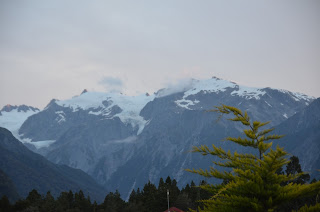Today was our last real day of exploration in New Zealand. It was really bittersweet, knowing that at this time the next morning we'd be on our way to the airport. The day began with waking up at Pohara Beach on Golden Bay. Several students slept on the beach, and woke up to the crashing sound and sight of green waves creeping alarmingly close to where they slept.
The rest of the camp woke sleepily and slowly. As the night before had been an extremely late one, many students found it hard to emerge from their tents in the morning. Soon, the thought of cereal and toast lured us out of bed, and we were quickly packed up and ready to go to the Nelson Region to walk amongst the remains of a ghost mine.
The drive took longer than expected because we had been misled to the entrance to the trail by good old Google Maps. We eventually found it, at the end of a long, winding, and isolated dirt road. We were greeted by the sight of the Roding River, marking the first of many crossings of it on the footpath. Traversing a rickety and somewhat dangerous-looking bridge, we began our hike through a unique section of New Zealand geology: a section of oceanic crust that had obducted onto the continent over 250 million years ago.
As we hiked through the exotic forest path, we were greeted at first by Permian mudstones and sandstones (more on those later). Our destination was the terrain above the now-abandoned United Mine, which ran only temporarily at the end of the 1800s in an economically futile attempt to mine copper.
We crossed the river a few more times, getting our feet (and sometimes more) just *slightly* damp - okay, maybe soaked. Many a time, supposedly "waterproof" boots failed to live up to their claims.
We passed on old smelting furnace, where copper ore was melted down, piles of slag still covering the nearby area.
After our last river crossing, the trees began to thin and eventually disappeared altogether. We were now standing on exposed land, with just a few short shrubs (and a lot of GIANT bees) surrounding us. This was our goal: the Dun Mountain-Maitai Terrain, a region of ultramafic lower lithospheric crust that somehow had managed to avoid being swallowed into the Earth. The missing trees were indicative of the huge quantities of phytotoxic heavy metals in the rocks and soil here.
At the stop, the assigned fourth-year students gave their talk on the area - the rare mantle-derived rocks and their serpentinized end-products - and then sent us off to collect some hand samples.
We analysed the orangish-brown rocks for their texture, colour, mineralogy, grain size, lithology, and structure, and broke some open to reveal beautiful olivine, pyroxene, and chromite crystals.
This was the base of the large section of now-upturned lithosphere preserved here. As we walked back, we were essentially hiking from the top of the mantle up through the Earth's crust. We passed intermediate igneous rocks, one showing a clear basaltic dike running through.
Next we walked along (or up?) through limestones, then sandstones and siltstones. The texture and colour of the changing rock was visibly apparent at the many outcrops by the river, as we traveled forward through time in more ways than one.
 |
| Outcrop next to river, with sunglasses for scale |
One of the best moments of the afternoon was when several students (and Russ!) jumped into the river to go for an impromptu swim; the swimming quickly evolved into jumping off rocks into deep parts of the river, after which we decided to get back to the geology and head back along the trail.
The last geological section were the Permian mudstones mentioned earlier; we were told about the abundance of fossils found in these rocks (at least, compared to the rest of New Zealand) and how these contained ammonites correlating the beds with accurately-dated European ones.
Eventually we made our way out of the woods and finally began driving to Christchurch, where we would be taking our flight out the next day. The cars separated and drove down the magnificent Eastern coast of the South island, taking in views of penguin-covered rocks and even a pod of whales making their way down the Pacific ocean.
 |
| Heading out of the woods |
 |
| Pine tree forests on slope of the mountain |
The drive was truly breathtaking; whether it was a field of sheep grazing at the base of a mountain.....
.....or vineyards that stretched in perfect rows as far as the eye could see...
....the scenery made us want to stay forever. While the drive was long, it was worth it to see the beauty of New Zealand one last time.
We all arrived at the Christchurch campsite at varying late times, and fell asleep almost instantly. Tomorrow, we're leaving. Our flight is going to be incredibly long: from Christchurch to Auckland, then Auckland to Melbourne, Melbourne to Dubai and finally Dubai to Toronto. Wish us luck! Thanks for reading. :)


















































